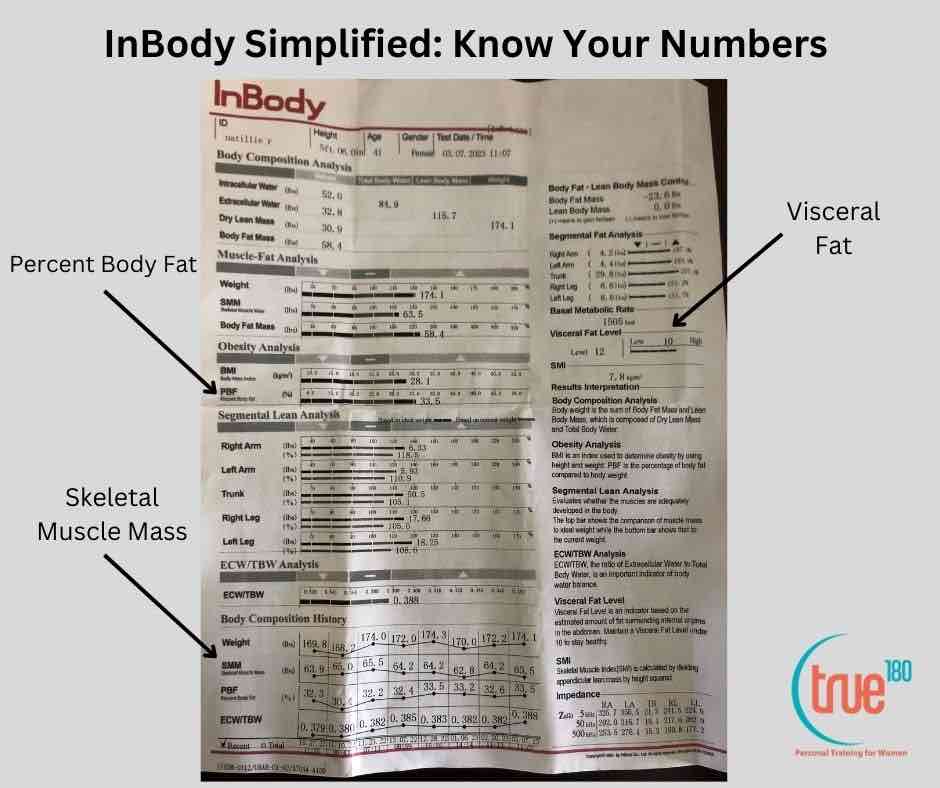| If you are currently a True 180 client, then you have stood on our InBody, which is included in all our training. We wanted to better help you understand what we are looking at and what it all means since it’s been awhile due to Covid and we want to help you not have this confused face, like Tina. When we look at the results of your InBody there are really only a handful of things we care most about: |

| Percent Body Fat (PFB) – this is the percentage of your body that is fat. This is far more important than weight, and this gives arguably the most important information about what is and isn’t happening in your body overall. Weight loss programs that focus solely on calorie restriction usually results in weight-loss where at least half is a loss in lean body mass (SMM below). This results in (a) being lighter at the same PFB, and (b) having a slower metabolism where regaining the weight is much easier. Over time we have found that these women return to their original body weight (or a little more) but at a much higher PFB because the weight regained is disproportionately fat. Visceral Fat Level – Visceral fat is the fat under your abdominal muscles that surrounds your organs and has the biggest potential for negative hormonal impacts on your body and inflammation over time. Unfortunately the system stops measuring at 20, and I would guess that the average American is over a 20. But, for health, this is second most important thing to look at. Eventually we are looking to get this to a 10 or below. (Interesting fact: when you’re over a 12 your risk for developing type 2 diabetes o heart disease is 50% higher than someone under 12. We set the goal at 10 to be conservative.) Skeletal Muscle Mass (SMM) – this is the amount of muscle mass you have in your body. Increasing the amount of muscle you have is the only thing you can do to legitimately increase your metabolism. There are no supplements, no herbs, no magical super foods that can actually boost your metabolism[1]. And, even though eating breakfast is a good idea, it does not boost your metabolism. Only muscle can elevate your metabolism. Period. When we look at SMM we really only have 2 questions: Do you have enough to support your current weight? and Is it distributed evenly enough to keep you safe. In regards to (1) If you don’t have enough muscle mass relative to your weight, then your metabolism will be too slow for you to easily maintain your current weight and getting into a calorie deficit will be harder. That’s a problem worth fixing! In regards to (2) we are looking for the balance between your upper body and your lower body – often the most injury prone have low levels of muscle mass in their lower body. What this means is that when they ask their legs to go up and down the stairs, quickly get out of the way, walk long distances they’re taking their body to it’s limits and beyond which is when injury risks are highest. Strength training will boost your capacity and allow you to do these activities of daily living with safety. Additionally for (2) we want to see if you have a large difference in muscle mass between your left and right side. If the difference is big enough we might add extra volume on your weaker side. How do we define Progress? Losing a pound of fat and gaining a pound of muscle do not “cancel” each other out. They add to each other. Improved body composition aka reducing your percent body fat (PFB) aka the technical term for increasing “tone”/”firming up” is both a concern for muscle and losing body-fat. Both keeping/building muscle are positive. The reason we invested $10,000 in the InBody was because it gives you accurate and consistent information that a scale can’t give you. |

